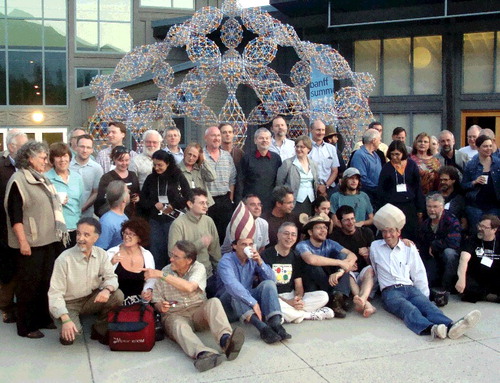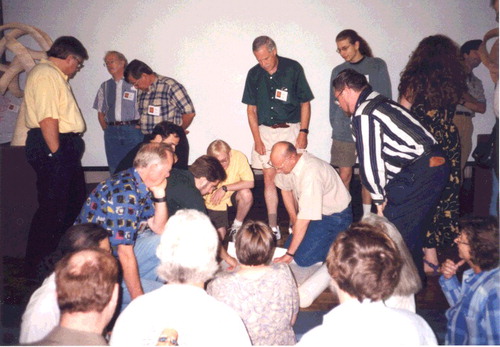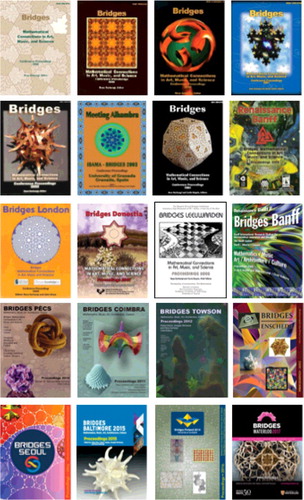Reza Sarhangi (1952–2016), as a mathematician, educator, and artist, had a profound impact on many interdisciplinary approaches to the study and teaching of mathematics and the arts. His vision and enthusiasm embraced and energized an international community of individuals engaged in explorations of intersections of art and mathematics. His legacy lives on despite his unexpected and premature death [Citation9]. He is best known for the success of his visionary endeavours surrounding the establishment of the Bridges Conference (Mathematical Connections in Art, Music, and Science), which has been transformative in the fields of math and art. With the great breadth of his interdisciplinary interests, coupled with his love of engaging people and ideas, he founded Bridges on a model developed by Nat Friedman, professor of mathematics at the State University of New York-Albany, for art–math conferences (1992–1998). Since its founding in 1998, Bridges has met annually () [Citation3, Citation5], attracting an ever larger cadre of artists, mathematicians, teachers, computer scientists, and the occasional art historian. Bridges began when Reza was teaching at Southwestern College in Winfield, Kansas, and it moved with him when he moved to Towson University near Baltimore, Maryland. Subsequently, Bridges expanded globally with academic collaborations that Reza negotiated with colleagues and their institutions in Granada, Spain (2003), Banff, Alberta, Canada (2005), London, United Kingdom (2006), Donostia, Spain (2007), Leeuwarden, The Netherlands (2008), Banff, Alberta, Canada (2009; ), Pécs, Hungary (2010), Coimbra, Portugal (2011), Enschede, The Netherlands (2013), Seoul, South Korea (2014), Baltimore, Maryland, USA (2015), Jyväskylä, Finland (2016), and Waterloo, Ontario, Canada (2017), which marked the 20th Bridges Conference. Papers, published in annual proceedings, are archived and available online [Citation4].
Figure 1. Twenty years of Bridges Conferences (1998–2017) Proceedings covers [Citation4].
![Figure 1. Twenty years of Bridges Conferences (1998–2017) Proceedings covers [Citation4].](/cms/asset/01f76b36-293b-420a-a225-0edd00901df3/tmaa_a_1469369_f0001_c.jpg)
Figure 2. Gathering of Bridges Conference attendees at Banff International Center, Banff, Alberta, Canada, 2009. Reza Sarhangi is kneeling at far left, front row. Photo, courtesy Carlo Séquin.

Drawing upon his broad interests in art, poetry, music, and theatre, Reza held a magnetic attraction for colleagues in all of these disciplines with shared interests in mathematics. From a conference of lectures focused on intersections of math and art, Bridges expanded to include workshops, musical performances, art exhibitions, poetry night, family day, short film festival, and theatrical programmes, all with mathematical content ().
Figure 3. This photograph, taken by Carlo Séquin in 1999 at the Bridges Conference in Winfield, Kansas, remained one of Reza's favourites because it lent itself to an interpretation of Raphael's painting, School of Athens (1510), with artists, mathematicians, and scientists conferring. Photo, courtesy Carlo Séquin.

Many other initiatives have spun out of Bridges, inspired by Reza's indefatigable vision and energy, including the Journal of Mathematics and the Arts published by Taylor & Francis in London, whose Associate Editors and editorial board emerged from their association with the Bridges Conference. One initiative was a workshop held in 2007 at the Banff International Research Station, addressing innovations in mathematics education via the arts [Citation1], reported on by Mara Alagic, a colleague of Reza's in Kansas, who worked with him in establishing Bridges at Southwestern College, and is now Editor-in-Chief of JMA. Reza initiated the Special Interest Group in the Arts of the Mathematical Association of America (SIGMAA), and stimulated the establishment of MoSAIC festivals (Mathematics of Science, Arts, Industry and Culture), a collaborative venture sponsored and funded by the Mathematical Sciences Research Institute in Berkeley, California, with a travelling exhibition circulated to college campuses throughout the US.
In addition to Bridges, the teaching of mathematics and his scholarly endeavours, Reza generated his own digital designs of mathematical tilings and tessellations, advancing this field by drawing upon his Persian heritage and addressing both theoretical and practical aspects of applied geometry. His memory lives on through his legacy shared through his exceptional generosity and insight, passionate energy, and dedicated commitment to exploring many forms of cultural expression with their mathematical intersections.
Widely published in the fields of math education and mathematics, Reza contributed extensively to the study and understanding of geometry in Persian art. His interests overlapped with mine as a historian of Islamic art and curator at The Textile Museum in Washington DC (1984–2001). He enthusiastically supported my studies of symmetry and pattern in Oriental carpets as intersections of art and mathematics. As a frequent participant at Bridges Conferences since 1998, my scholarship on mathematical aspects of Islamic art and architecture bears the imprint of Reza's influence and enthusiasm, as reflected in my publications [Citation2].
Reza served as Guest Editor for two special issues of Nexus Network Journal. The first, published in 2012, was devoted to Persian Architecture and Mathematics [Citation7], to which I was an invited contributor. The second followed in 2016, exploring Persian Architectural Elements and Design [Citation8]. From 2005 onward, apart from his teaching and art, and his visionary leadership of the annual Bridges conferences, he devoted himself to the study of Abu al-Wafa Buzjani's Persian manuscript on geometry for craftsmen and solved many geometric problems posed by Buzjani, as well as those in an appended text that remains anonymous. Reza's untimely death in 2016 precluded his finishing an illustrated commentary comparing old and new drawings of these problems for publication. The results of his initial inquiry into this work, ‘Illustrating Abu al-Wafā’ Būzjānī: Flat Images, Spherical Constructions’, appeared in a special issue of Iranian Studies [Citation6], entitled Sciences, Crafts, and the Production of Knowledge in Iran and Eastern Islamic Lands [Citation10].
In light of Reza's passionate research interests, the Call for Papers for this special issue of the Journal of Mathematics and the Arts honouring his memory sought to advance the particular fields of his own endeavours. This was conceived to include traditions of Persian art and architecture treated in relation to mathematics: symmetry, tilings and tessellations, modularity and modular systems, polyhedral and spherical geometry, and interdisciplinary mathematics and arts education. The manuscripts received, reviewed, revised, and ultimately accepted cluster around the spatial dimension with two emergent themes strongly present – tilings in the plane and perspectives on the sphere, which led to the arrangement of articles in this double issue. Symmetry as a generative tool for design, and as an analytical tool for the study of patterns, finds a useful presence in both clusters, but it is not the only organizing principle addressed, nor is it the only basis for design algorithms. Fractals, projective geometry, and hyperbolic space are also addressed, as is the Möbius band, with its topological challenge of dimensionality considered in real space.
The first cluster of articles concerns tilings in the plane: Mamoun Sakkal, an architect and designer of typography and Arabic fonts, brilliantly analyzes in text and image the ornamental brickwork of a key architectural monument in Samarkand of the fourteenth century, which reveals a variety of ways that two square grids can overlay and intersect to encompass Square Kufic calligraphy, used for pious Arabic texts selected at the court of Timur. Eduard Taganap and Louise Antonette De Las Peñas amplify the understanding of tilings to incorporate hyperbolic isocoronal arrangements. Also related to the hyperbolic plane is the artist's statement by Phil Webster, trained in mathematics and cognitive science, who explains the method he developed for generating fractal patterns based upon a traditional Islamic tiling. Doris Schattschneider, a mathematician and math educator, highlights the MAA Tiling, located in Washington, DC, in the foyer of the headquarters of the Mathematical Association of America, and places its tessellation of congruent non-regular convex pentagons in historical context, describing the heuristic method of its discovery by Marjorie Rice (d. 2017).
The second cluster of articles explores spherical geometry from dramatically different perspectives: Jay Bonner, a designer of Islamic ornament, examines dimensional jitterbug transformations, originally associated with R. Buckminster Fuller, in the context of historical Islamic monuments with potential for contemporary applications. António Bandeira Araújo documents the mathematics behind the projection of spherical perspective, familiar in painting since the Renaissance, and advocates for a construction using compass, ruler, and nail. Patricia Bentley examines the use of a planar astrolabe marked with a spherical projection, which was made in 14th-century Spain with inscriptions in three languages (Hebrew, Latin, Arabic). As a museum professional and educator, Bentley discusses the use of this object in a museum collection today, while considering its historical and cultural significance, noting its markings that map a geometric projection of three-dimensional space in two dimensions to enable the measurement of altitudes and distances of celestial bodies. This special double issue concludes with a delightful portrayal of Möbius bands in real space, with an article by Carlo Séquin, a long-time Bridges participant, sculptor, mathematical artist, and professor of electrical engineering and computer science, who discusses key concepts and the geometric constraints that allow for the construction of bridges that are topologically equivalent to Möbius bands. Profound thanks to each of these authors for their thoughtful contributions honouring the memory of Reza Sarhangi, while advancing scholarship in many fields through careful and critical documentation, interpretative analyses, and theoretical constructs and modelling. As a eulogy, we present a mathematical poem by math professor and Bridges participant, Sarah Glaz, entitled Two bridges: in memory of Reza Sarhangi, in which the poetic writing shares details of structure, design, and composition with a digital work by Reza.
Taken together, the articles in this special double issue offer a balance of subject matter, addressing many aspects of intersectionality in mathematics and the arts. Individually, they touch upon architecture, design, pattern, structure, form, and repetition, history and theory. And they represent a variety of humanistic endeavours, professional interests and disciplines. Encircling the globe, the contributing authors present a diversity of perspectives on subjects pertinent to Reza's areas of academic and personal interests. I imagine he would be very pleased to see these interdisciplinary interests advanced in so many directions.
A final note of thanks goes to our reviewers, whose quiet commitment and dedication to interdisciplinary scholarship too often goes without sufficient acknowledgment. They are asked to review manuscript submissions, determine their suitability for publication, and offer suggestions to improve quality of writing and rhetoric, serving as advocates for our readers. As editor for this special issue honouring Reza's memory, I sought the advice and guidance of many of Reza's friends, several of whom I know through their participation at Bridges Conferences. Each article was reviewed by a practitioner or scholar in the arts, and by someone professionally involved in mathematics or its applications in computer science, architecture or design. Their individual and collective contribution to the quality of this special issue of the Journal of Mathematics and the Arts is very much appreciated, and our respective fields benefit from their exceptionally thoughtful and thorough reviews.
Moving forward, the articles presented here – addressing aspects of historical Persian art and architecture, tessellations and tilings, and spherical geometry both in real space and projected on the plane – advance so many fields in which Reza Sarhangi was passionately involved and active. They all involve intersections of mathematics and the arts, for which he so avidly and actively got others involved, fostering their efforts, encouraging participation, and inspiring collaboration and the sharing of ideas. Our extended love remains with his life partner and wife, Mehri, and his daughters, Mona and Maryam. May our memories of him and his magnanimous legacy continue to inspire us to advance our understanding of the natural intersectionality of mathematics and the arts.
Disclosure statement
No potential conflict of interest was reported by the author.
References
- M. Alagic , Innovations in mathematics education via the arts - BIRS Workshop 2007 Banff, Alberta, Canada . J. Math. Arts. 1 (2007), pp. 203–207. doi:10.1080/17513470701585977
- C. Bier , Selected Works of Carol Bier (Categories: Geometry and Islamic Art; Islamic Art and the Mathematics Curriculum) , 2018. Available at: http://works.bepress.com/carol_bier/.
- The Bridges Organization . Available at: http://bridgesmathart.org.
- Bridges Past Conferences . Available at: http://bridgesmathart.org/past-conferences/.
- K. Fenyvesi , Bridges: A world community for mathematical art . Math. Intell. 38 (2016), p. 35. Available at: http://bridgesmathart.org/uploads/HistoryOfBridgesCommunityMathematicalIntelligencerFenyvesi.pdf.
- R. Sarhangi , Illustrating Abu al- Wafā ' Būzjānī : Flat i mages, s pherical c onstructions , in Sciences, Crafts, and the Production of Knowledge in Iran and Eastern Islamic Lands , N. Yousefi , E. Kheirandish , and C. Bier , eds., 2008, pp. 511–23.
- R. Sarhangi (ed.), Persian Architecture and Mathematics . Nexus Netw. J. ( Special Issue) 14 (2012).
- R. Sarhangi (ed.), Persian Architectural Elements and Design . Nexus Netw. J. ( Special Issue) 18 (2016).
- S. Shrestha , In memoriam, Reza Sarhangi , J. Math. Arts 10 (2016), pp. 1–3. doi:10.1080/17513472.2016.1265910
- N. Yousefi , E. Kheirandish , and C. Bier (eds.), Sciences, Crafts, and the Production of Knowledge in Iran and Eastern Islamic Lands Iran. Stud. ( Special Issue) 41 (2008).

